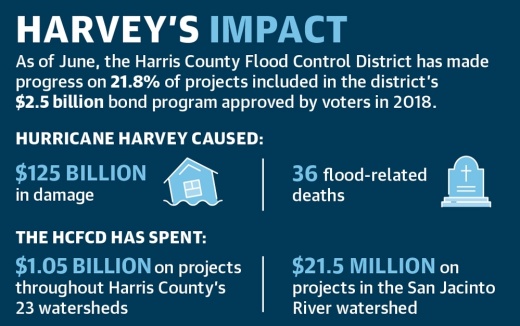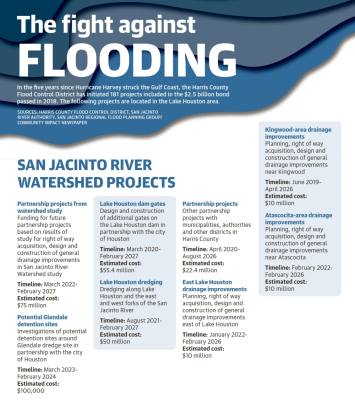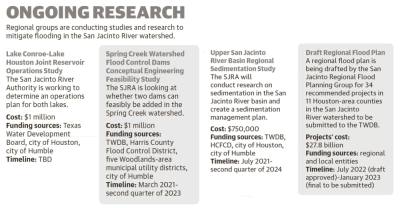As of June, the Harris County Flood Control District’s $2.5 billion bond program, which voters approved in 2018, was 21.8% complete, according to the district’s monthly report. HCFCD Executive Director Tina Petersen said bond projects require time-consuming steps before construction begins, including studies, engineering and design.
“Where we’ve been focused over the last several years is more on what happens inside the district, ... but as we move further into the bond program, more and more of these projects that we’ve been studying and designing are going to happen,” Petersen said.
Efforts are underway on projects in the Lake Houston area with more planned as funding becomes available, according to the HCFCD. To supplement the $2.5 billion in bond funding, the HCFCD anticipated receiving an additional $2.5 billion from grants and local partnerships, although finding funding partners continues to be a challenge for the district.
Projects along the San Jacinto River—including the West Fork, which runs through the Lake Houston area—account for about $37.9 million in designated bond funding, according to the HCFCD. As of July, $21.5 million of this funding had been spent.
Montgomery County projects are being tackled through coordinated efforts, said Matt Barrett, the manager of the San Jacinto River Authority Water Resources and Flood Management Division. The SJRA is conducting three surveys to determine the feasibility of potential flood mitigation projects along the West Fork of the San Jacinto River.
In February 2021, the SJRA received almost $1.4 million in funding for the studies from the Texas Water Development Board with additional funding coming from the HCFCD and the cities of Houston and Humble.
“Hurricane Harvey was the big catalyst for [Gov. Greg Abbott] to come to us and kind of really tell us, ‘Hey, you need to be involved in [flood mitigation] and see what you can do to help,’” Barrett said.
Making progress
Not long after Harvey flooded the area in 2017, the city of Houston began working to add gates to the Lake Houston dam. This project is in the design process, according to an Aug. 4 news release, but officials plan to release an update in September.
“The age of the Lake Houston Spillway dam, built in 1953, is proving to be a huge obstacle for this project as it continues to move forward. ... Another factor complicating this project is the cost variations between alternatives as project costs are outside of the existing federally funded amount—$48 million,” the release reads.
The project aims to fix the shortcomings of the dam—which officials said were highlighted during Harvey as it was overwhelmed with water—by adding 500 feet of gates to the Lake Houston spillway.
In December 2020, the San Jacinto River Regional Watershed Master Drainage Plan was completed by the HCFCD in partnership with the SJRA, Montgomery County and the city of Houston. The report recommended 16 projects with an estimated cost of $3 billion, Barrett said, including studies being conducted by the SJRA.
Barret said completing the 16 projects outlined in the master drainage plan would take 10-20 years per project.
Meanwhile, the SJRA is conducting a $1 million study to determine efficient and safe operations for Lake Houston and Lake Conroe after more gates are added to the Lake Houston dam, according to the SJRA’s Flood Management 10-year Project Plan. Additional studies being conducted by the SJRA and partners include a feasibility study for additional dams in the Spring Creek watershed and a study researching where sediment originates and is stored in the San Jacinto River basin.
The Spring Creek watershed dam study and the San Jacinto River basin sediment study—estimated to cost $1 million and $750,000, respectively—are ongoing, while the Lake Houston-Lake Conroe gate study has not yet begun.
“We’re on hold at the moment on that one until they determine what the plan is for those gates at Lake Houston because that really is going to help drive what we’re going to do,” Barrett said.
In addition, local HCFCD projects executed from the 2018 bond include a funding partnership with the city of Houston to complete dredging along the West Fork of the San Jacinto River and Lake Houston, which is expected to be completed in 2027.
In the Kingwood area, the HCFCD is in the preliminary stages of improving Bens Branch, Kingwood Diversion Ditch and Taylor Gully. In Atascocita, a study on the tributaries to the south of the West Fork of the San Jacinto River and west of Lake Houston launched in February to identify flooding solutions.
The bond also allocated $20 million for a study to determine the feasibility of constructing underground tunnels countywide to move stormwater from flood centers to a larger body of water. The HCFCD completed Phase 2 of the study in June and estimated a system of eight tunnels would cost $30 billion.
Fighting for funding
The HCFCD continues efforts to close the partnership funding gap, Petersen said. As of June 28, the district had secured $1.275 billion in partnership funding with another $754.2 million still needed to fund projects from the 2018 bond.
The U.S. Department of Housing and Urban Development approved a Texas General Land Office amendment to allocate $750 million to Harris County in March following opposition to the GLO’s May 2021 decision not to award funds. According to David Berry, Harris County administrator and budget officer, the county is in the negotiation and allocation process for the remaining $750 million.
“We believe that both Harris County and the city of Houston should receive at least $1 billion each for [flood] mitigation,” Berry said in an email.
Another way the district is bridging the funding gap is through the $834.2 million Flood Resilience Trust, which Harris County commissioners approved in June to fill project needs when partnership funding is unavailable, Petersen said. Funding for the trust comes from reimbursements from the state and federal government as well as money left over from completed bond projects and county mobility funds.
The HCFCD reported in late June that no 2018 bond projects had been delayed due to a lack of partnership funding, but funding from the trust would be needed to avoid future delays in certain projects. With $124.9 million in bond funds available from the trust, the bond program will be able to run for the next year, according to county documents.
“One of the things that we have in the works is a process to make sure that the cost estimates that we have on paper are going to be accurate because we do know that costs are going up,” Petersen said.
For the SJRA, funding can pose a challenge when tackling multimillion-dollar projects, Barrett said.
“Those dollar amounts are so large that local entities are going to have trouble funding them, regardless whether they have a dedicated funding source or not,” he said.
Wesley Gardner, Jishnu Nair and Kelly Schafler contributed to this report.










